Looking for asana alternatives? This post will show you 25 best asana alternatives that you have never witnessed before. You can choose the project management tool that is best for you with the aid of this list of alternatives to Asana. Most likely, you’ve heard of Asana. Although they are frequently used for basic task and project management, busy teams with increasing workloads frequently require more. Therefore, if you’re unsure if it’s the ideal fit for your team, this post will assist you in locating the best Asana rivals.
You may choose whether software solution is worth further investigation by reviewing the best Asana alternative, Workzone, the advantages and disadvantages of Asana, and 25 other software options.
Ranking the Best Project Management Alternatives to Asana
Workzone is now rated as the top Asana alternative by users at Capterra, Software Advice, and GetApp in all ranking categories, including overall, functionality, ease of use, value for money, and customer support.
Workzone is the top-ranked Asana alternative.
greater exposure for the work of your team
Asana excels at handling straightforward task lists but falls short in some crucial aspects.
Only Workzone’s Project Dashboard allows users to see every project at a glance.
Project managers with expertise at your side
With minimal individualized onboarding and assistance, Asana provides a free trial.
All customers are given unrestricted support by Workzone. No other software product on the market comes with such a comprehensive onboarding and training program as part of the subscription price.
everything you require for project management
Although Asana has an enhanced user interface, it lacks the essential resources that teams require to succeed. Workzone was developed over 20 years and blends user-friendliness with powerful capabilities. granting you access to cutting-edge features that improve project management.
20+ Asana Alternatives for Managing Projects Effectively
1. Workzone

Positives: Workzone is the ideal Asana rival. Workzone tops the list of Asana substitutes because it is both more robust and user-friendly than Asana. Workzone can offer a portfolio view of all projects, task dependencies, Gantt charts, and superior reporting, among other things that Asana cannot. Additionally, it is much easier to use than cumbersome applications like Microsoft Project.
Here are some of the main advantages of Workzone vs Asana:
- Individualized to-do lists help people stay on task (and can be automatically emailed each day)
- For each project, you can associate, distribute, and save documents.
- Portfolio views of all team projects are provided by project dashboards.
- Unlimited assistance and thorough onboarding help your staff quickly come up to speed.
- Visual project tracking is facilitated by interactive Gantt charts and calendars.
- Establish access levels for each project and document so that each user only sees what is necessary.
- As necessary, modify your own project request forms and reporting
- Import Microsoft Excel and MS Project files (.mpp)
Cons: According to some users, Workzone’s search feature needs to be improved.
Workzone is a fantastic project management tool for team communication, according to the review. It is reliable and simple to use. Being hosted in the cloud makes it ideal for teams that are distributed. My favorite aspect of Workzone is also their excellent customer service. You can effortlessly keep tabs on the advancement of your project with Workzone. Another wonderful feature is the automatic email reminders sent to team members regarding important project tasks.
Your entire team can instantly sign up with Workzone, collaborate on files, and quicky understand where each project stands. There will be fewer meetings and less trouble for projects that go more smoothly. Workzone is a fantastic choice for you and your team if you love Asana but need something more potent.
2. Trello
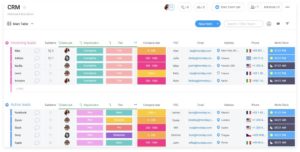
An Atlassian subsidiary called Trello specializes on project management in the Kanban manner. Each project is shown as a “board,” divided into “lists” and “cards,” which may be moved between lists as they advance through the project’s various stages. Trello is included in the list of Asana alternatives since it offers a reduction in features.
Pros: Trello is an easy-to-use platform that may be appealing for new teams managing modest, straightforward projects. It distinguishes itself from other project management software with its simple visual design. You may easily switch between the desktop and mobile user interfaces, and you can even send cards to yourself via email.
Cons: For smaller, easier projects, Trello works best. Project managers who are worried about estimates, budgets, and dependencies should avoid using Trello. Trello isn’t the right tool for you if you prefer to view your project in a Gantt chart, as well.
Free – $20.83 per user each month
3. Jira
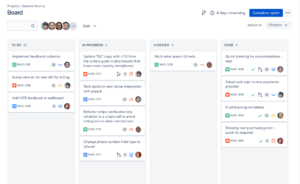
The company’s primary product, Jira, was created by Australian software company Atlassian. JIRA may support Lean, Kanban, and Scrum project management, but it is best known as the pioneer in devOps. Jira started out as a bug tracking program but has evolved into a well-liked project management tool.
The ability to combine Jira with hundreds of other applications and its over a thousand add-ons make it very configurable. Jira can produce excellent reports for both agile project management and roadmapping. It also includes the ability to track issues and set priorities.
Cons: JIRA works well for technical teams that track a lot of issues and bugs. Most teams require more intuitive software. It has a unique set of rules that may be challenging to understand.
Free to $14 per user each month
4. Scoro

Project planning, time tracking, contact management, and billing are all included in the single work management program Scoro. Within Scoro, you can also find a wide range of products, from project management to CRM.
The biggest benefit of Scoro is keeping your CRM integrated with your project management duties. Since the software incorporates time tracking, billing, quoting, and invoicing, it also performs exceptionally well when handling client work.
Cons: “Comprehensive” productivity suites like Scoro aren’t as powerful in each area as separate CRMs or project management programs. Having an all-in-one solution is less desirable now that there are so many connectors available.
Price: $22–$55 per user each month
5. ClickUp

Users of the web tool ClickUp can complete all of their tasks in one location. “One app to replace them all” is their tagline.
Advantages: ClickUp is an easy-to-use platform for managing teams and projects of any size. It boasts an intuitive user interface and a hierarchy of many project views. Check this article on ActiveCollab alternatives.
Cons: ClickUp is a comprehensive offering. “All-in-one” solutions attempt to do too much all at once all too frequently. For new project software users, this amount of flexibility might be overwhelming. Some individuals believe it would be too challenging to successfully implement given the variety of features and integration options.
Pricing: Free with a Business plan quote of $9 per user per month.
6. Proofhub
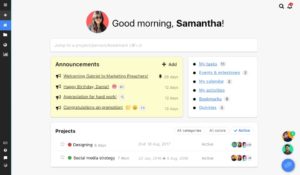
Proofhub is a “all-in-one” project management tool that was introduced in 2011.
Positives: Proofhub’s ability to provide proofs is its key selling point. On creative work and papers, you may immediately edit and add comments. Gantt charts, Kanban boards, calendars, timesheets, request forms, timers, custom roles, chat, discussions, and other project management tools are all available through Proofhub.
Cons: Actually one of the most expensive choices on this list is Proofhub. Because there is no free version of Proofhub, it could not be affordable for small teams on a limited budget. Additionally, some customers argue that the user interface needs work and that there aren’t enough integrations available.
Price: $45 to $150 per month
7. ProjectManager.com

A powerful project management tool called ProjectManager.com was created in 2008 in Austin, Texas, by ProjectManager.com, Inc. The full complement of project management tools is available at ProjectManager.com. It supports both Waterfall and Agile project management techniques. You can track time, collaborate, manage projects and team progress, and report on how things are doing with the aid of the program. Check this article on Insightly alternatives.
Cons: Some customers claim that customization options are limited, particularly for reports and notifications. The software’s slowness has also been a source of some complaints.
Price: $15 to $25 per user each month
8. Wrike

Project management tool Wrike was developed in 2003 by San Jose, California-based Wrike, Inc. The idea of folders and nested folders is the foundation of the tool.
Pros: Wrike includes a ton of functionality and a variety of project management views. Gantt charts, timelines, cards, and boards have been implemented so that users can work how they wish.
Cons: Because Wrike is so customisable, it might be challenging to teach and integrate new staff into the system. Wrike is constrained by an unintuitive folder-based architecture that keeps piling more and more on top because it was first intended to be a document sharing solution that later evolved into project management.
Pricing: Free with a quoted monthly user fee of $36.40 for businesses.
9. Project Microsoft
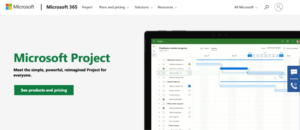
The oldest project management program available, Microsoft Project, must be included in a list of Asana alternatives. MS Project, which has been around since 1984, is still well-liked among PMPs (Project Management Professionals) and large enterprises with formal PMOs today (Project Management Offices.)
Pros: MS Project provides essentially all the features you’ll require, and it works well with other Microsoft applications like Excel and Outlook. It is strong and packed with functionality, such as tools for planning and scheduling, resource management, and Gantt charts.
Cons: MS Project was the preferred choice for a very long period. However, the successor platforms that it made possible have since surpassed it. It offers fewer integration options, is less streamlined and straightforward than many of its more contemporary rivals, and lacks mobile functionality. Additionally, because to its complexity, you definitely require an administrator to oversee the software if your team doesn’t include PMPs.
Pricing ranges from $12.80 to $70.40 per user per month for cloud-based solutions and from $769 to $1,719 for on-premise systems, with customized quotes for project servers.
10. Nutcache

A subsidiary of the Canadian accounting software company Dynacom Technologies Group, Nutcache was created in 2013. Initially only an invoicing app, the program has now been crammed with project management tools like discussion forums, file sharing, and time tracking. Check this article on Engagebay alternatives.
Positives: From the initial project estimate to the final client invoice, Nutcache is a system created for managing the full project delivery lifecycle. The main benefit of Nutcache is that it is designed to make it simple for you to bill clients who pay by the hour. This can be the best option for your team if you manage lots of little tasks and charge your customers hourly.
Cons: Nutcache was created as billing software by an accounting business. Although it has expanded to cover many project management tools, it lacks some features that your team might not be able to live without, such configurable templates and Gantt charts. Additionally, Nutcache does not support traditional techniques like Waterfall; rather, it exclusively supports Agile projects.
Cost: $6 to $12 per user each month
11. Workfront

This 2001-founded Utah-based project management business serves Enterprise-level clients by integrating complicated project management with issue tracking, document sharing, and portfolio management. Check this article on Podio alternatives.
Pros: Next to Microsoft Project, Workfront is arguably the most feature-rich alternative on this list. It is a strong platform that can meet the needs of both mid-sized and large organizations.
Cons: Workfront is more of an enterprise level application than an Asana substitute, making it potentially too expensive and sophisticated for teams and small organizations. Expect a lengthy onboarding process with an unappealing design because it’s not the easiest system to learn.
Pricing: Request pricing; not made public.
12. ProWorkFlow

Julian Stone developed ProWorkFlow, a web-based project management tool, in 2002. The following year, ProActive Software Limited bought it.
Pros: ProWorkFlow is yet another tool that has just about every function you can think of. The capacity to be customized is the program’s greatest asset. You can design unique views for particular employees or various views for various employee kinds. If certain individuals just require access to the duties they have been given, they will only see those. Check this article on Pipedrive alternatives.
Cons: For the individual setting up ProWorkFlow, it can be frightening. The fact that the reporting tools and templates are so basic has also drawn criticism. Another frequent complaint is that the mobile app needs improvement.
Pricing: $10-$30 per user each month with a minimum number of users
13. Mavenlink
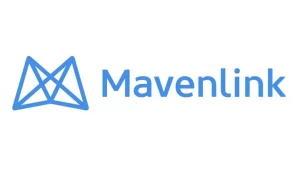
Mavenlink is one of the more somber tools on this list, both in terms of its functionality and attitude. Compared to Asana, Trello, or Nutcache, it seems much more professional. The most appropriate analogy would be a more up-to-date Microsoft Project. Because it focuses on the financial capabilities that some teams actually require, MavenLink is included in the list of Asana alternatives.
Pros: Mavenlink stands out for its financial features, which enable teams to pay suppliers or contractors directly from the application. You can see the crucial path immediately with its reports and charts because they are automatically updated. Check this article on Copper alternatives.
Cons: If keeping track of your project’s funds is not your primary objective, another solution might be more suitable for you. You get the impression that Mavenlink is sending the message that “the workplace is for work, no distractions” by not having a mobile app or an integrated messaging tool. If you are actually looking for a straightforward alternative to Asana, Mavenlink is a good option.
Pricing: Premier and Enterprise solutions are privately quoted at $19 to $39 per user per month.
14. Redbooth
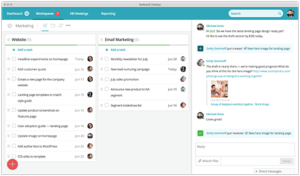
A great intermediate step between Asana and some of the most potent, feature-rich apps on this list is Redbooth.
Pros: If you enjoy Asana but have discovered that they don’t offer some capabilities you require, you’ll likely find them at Redbooth. Asana-like in its simplicity and ease of use, Redbooth also provides Gantt charts, assignable subtasks, productivity reports, and other features. And it’s also less expensive.
Cons: Some individuals believe the program to be excessively nimble. Lack of built-in security and governance around who may add and alter information as well as how new projects and tasks are set up has caused problems for users. Errors could be a problem if the system will be used by many users.
Price: $0 to $15 per user per month
15. Teamwork
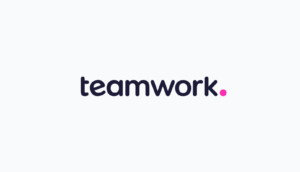
With its main office in Ireland, Teamwork offers a comprehensive selection of productivity solutions, such as project management software, a sales CRM, and help desk software.
Pros: Teamwork may contain the sophisticated capabilities and extensive business software you require. Invoice tracking, real-time team member status updates, and privacy and permissions are just a few of the robust project management capabilities.
Cons: Because Teamwork is a “all-in-one” solution, it may be too complex for small teams that are inexperienced in project management. Additionally, it is one of the more expensive alternatives to Asana.
Pricing: The Small Office plan costs $44.92 per month, the Professional plan costs $136.58, the Business plan costs $228.25 per month, and the Enterprise plan is not specified.
16. Slack

One of the most well-liked project management software is Slack. The only major issue is that it’s just a tricked-out instant messenger and not truly a project management program. Slack is included in the list of Asana alternatives because many users desire a more social, message-based method of collaboration.
Pros: Slack is a good option if all you truly need is a centralized location where your team can share files and communicate. You can use it to build distinct channels and groups with their own security configurations. It can be integrated with other project management applications, and users can receive automated notifications and reminders.
Cons: Slack isn’t a stand-alone project tool; it may be used in conjunction with a more specialist project management app. It lacks the ability to do essential project management tasks including monitoring task progress, generating reports, and keeping track of deliverables.
Price: $0 to $15 per user per month
Check out our blog post for more information about Slack and a list of Slack alternatives.
17. QuickBase

QuickBase stands out from the other Asana competitors on this list because it can be used to create your own, personalized project management software rather than being a project management program itself.
Benefits: QuickBase eliminates the need for any coding at all. Simply build a list of all the features and functions your app must have, combine them in QuickBase, and presto! You have a solution that satisfies every requirement of your team.
Cons: Before you can utilize QuickBase as a project management solution, a team devoted to making it happen is required because it is not ready out of the box.
Price per user/month: $15-$40
18. Smartsheet
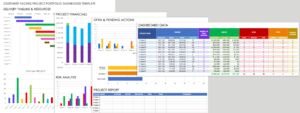
Smartsheet assists many teams in completing their task by providing a comprehensive set of capabilities that go beyond project management software. Because they are both well-funded venture-backed businesses, Smartsheet is included on the list of Asana alternatives.
Advantages: Smartsheet outperforms the conventional spreadsheet, therefore if you enjoy using spreadsheets, you might be a natural user of Smartsheet. Formulas can be used in conjunction with conventional project management tools like Critical Path.
Cons: Because Smartsheet is designed to resemble a spreadsheet, it has limitations when it comes to efficiently managing the resources and activities of more complicated projects. Multiple “sheets” can be created by project managers for various projects. However, the sheets can go on forever and be too much to handle! The same issues with using Microsoft Excel remain after then.
Individual plans cost $14 per month, team plans cost $15 per user per month, business plans cost $25 per user per month, and enterprise plans are quoted.
19. Targetprocess

Based in Buffalo, New York, Targetprocess provides agile project management software for SAFe, Kanban, Scrum, and other agile processes.
The card style and display of Targetprocess enable the inclusion of more tasks in timelines and milestones. It is simple to use, has one of the most comprehensive free plans available, and has a stellar reputation for customer service.
Cons: Neither the most elegant nor the most powerful program is Targetprocess. The software’s user interface can be unnecessarily complicated for certain users, and it frequently takes time for team members to become proficient.
Pricing: $20 per user each month, with special quotes for enterprise level pricing
20. Podio
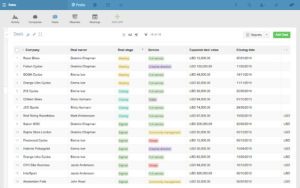
Citrix acquired Raleigh, North Carolina-based Podio in 2012. The “open-plan online workplace” and the concept of transparency are the foundation of Podio.
Advantages: The fact that you never have to leave makes Podio appealing. It is the project management industry’s megamall. To check your email, you can do so in Podio without switching tabs. To check the style guide, do you need to open Word? No, that’s possible in Podio.
In comparison to many of the other tools on this list, it includes more social aspects like peer recognition and sharing. Because Podio serves as a social network for everyone you work with, you don’t even need to open an incognito window to check Facebook.
Cons: Podio wasn’t designed to handle extensive projects or portfolios. It lacks a portfolio view or all-projects dashboard to make it easier for you to keep track of all open projects.
Free to $24 per user each month
21. Quip
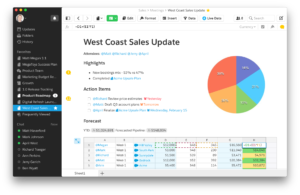
Quip, which combines documents, spreadsheets, slides, and chat into one location, is to Google Docs what Slack is to Google Hangouts (no, not the toothbrush).
Pros: Quip just offers you one function, but it does it well. It doesn’t provide you with a full range of project management tools. It works best for small groups that collaborate uniformly across all of their tasks.
Cons: Quip prioritizes encouraging participation above project management. You’d be better off searching elsewhere if you needed project management that was more complex.
Price: $30 per month for the first five users and an additional $10 per month for each additional user.
22. Pivotal Tracker
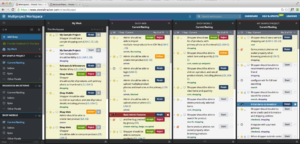
Software development projects are managed using the agile project management platform Pivotal Tracker. Similar to Asana’s board view, Tracker displays tasks as virtual cards called tales that go through your workflow.
Positives: Pivotal Tracker encourages you to break projects down into smaller, more manageable pieces and to hold crucial discussions about scope and deliverables. Hard deadlines don’t exist for stories. Instead, they are intended to aid your team in adjusting when priorities shift and pacing work.
Cons: Although this approach is quite effective, it is unquestionably not for everyone. Additionally, Pivotal Tracker is quite inflexible, making it pointless to attempt to use it in a different way. Tracker isn’t the ideal choice if you don’t manage software development or don’t follow the agile project methodology.
Which is true: Your choice. Your schedule is divided into intervals known as “iterations,” and you are given a specific number of “stories” or tasks for each iteration. There are no deadlines for stories; instead, they are assigned a number of “points” based on how challenging they are.
Pivotal Tracker tallys your completed points at the conclusion of each iteration to calculate your velocity score, which determines how many points you should receive in subsequent iterations.
Cost: $0 to $250 per month
23. Basecamp

One of the most well-known project management software for most project managers is Basecamp, which is based in Chicago, Illinois, USA. Project management is made simpler by Basecamp so that it is understandable to more individuals. Basecamp is included on the list of Asana substitutes because they are frequently used side by side.
Advantages: Basecamp is simple to use and quick to set up. Although Basecamp lacks more sophisticated project management tools like Gantt charts, time tracking, and dependent subtasks, it is still a desirable platform for teams who don’t want all the bells and whistles.
Cons: Users can only view one project at a time on Basecamp, which is possibly its largest drawback. Teams that manage a lot of work want the capability to monitor numerous projects simultaneously in order to understand where each project stands.
Personal usage is free; business use is $99 per month for an unlimited number of users. Another tool, Basecamp, does not have a free option (unless you are a student or teacher), but it does have a set pricing for an infinite number of users, making it a fantastic deal for big businesses.
Basecamp may be an excellent starting point, but if you want to climb to the top of the project management mountain, you may need to go elsewhere.
24. LiquidPlanner

Because of its powerful scheduling capabilities, LiquidPlanner—which bills itself as smarter project management software for nimble teams—makes the list of Asana alternatives. LiquidPlanner lives up to its name and is excellent for teams with dynamic schedules (because, let’s face it, whose isn’t?).
Pros: Do you find it challenging to plan your projects? LiquidPlanner’s dynamic timelines automatically adjust to create space for changes whenever you change a task priority or add more work to your team, ensuring that everything moves down the path of least resistance and saving you a ton of time.
Cons: LiquidPlanner was primarily created for technical users, thus if your staff is unfamiliar with project management software, acceptance may be difficult.
Pricing: $45 per person each month, plus a separately quoted Enterprise package
25. Bitrix24

Project management tasks, social intranet, and CRM are all combined in Bitrix24. Like if you combined Salesforce with your project to-do list but desired something more straightforward
Benefits: One significant benefit of using Bitrix24 is being able to keep track of all of your projects, interactions, and business updates in one location. There are variants that are self-hosted and cloud-hosted. Because Bitrix24 is essentially Facebook repurposed into a project management platform (maybe Asana could have grabbed that idea?! ), it goes one step further than Asana. You can post messages, files, or events in the Activity Stream, which is quite similar to Facebook’s News Feed, and you can also view what other people are doing and comment on it. Each user can make as many photo albums as they want in the Photo Gallery and add photos to them. For crying out loud, a Like button exists!
The sidebar is one way that Bitrix24 and Facebook differ. Bitrix24 offers a variety of project management tools, including task management, reporting, and Gantt charts, similar to how Facebook connects you to games, pokes, and secret groups.
Cons: Due to fixed constraints on storage, email sending, invoicing, the amount of projects, and other factors, it can be challenging to determine which level of Bitrix24 is best for your team. If you got a large team, you’ll probably need to upgrade past the fundamentals, just like with the other free-to-paid options.
Pricing: Free for the cloud version and $159 per user per month; $1,490 – $24,990 for on-premise
26. Monday
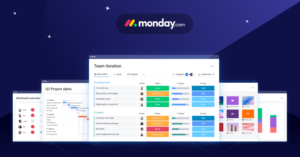
The company underwent a significant shift in the past few years that increased production and resulted in the name change from daPulse to Monday.com. They substituted the term “pulse” for the phrase “tasks” since, as we all know, Mondays can be a drag.
Pros: Monday claims to make your Mondays happier with their cheerful and colorful software. Teams can easily get started with some essential project management tools they need to use in order to be successful because of the cheaper price point.
Cons: Similar to free-to-paid alternatives, where each tier gives you extra functionality, the most useful team-focused features are reserved for the Enterprise tier.
Starting at $39 per month for five users
Conclusion
As you can see, there are other options for project managers in 2022 than Asana. It just takes choosing the best one from among the various Asana alternatives that are tailored for every conceivable kind of project, team, or business. Hopefully, one of these Asana alternatives—both free and paid—is the ideal fit for you.

